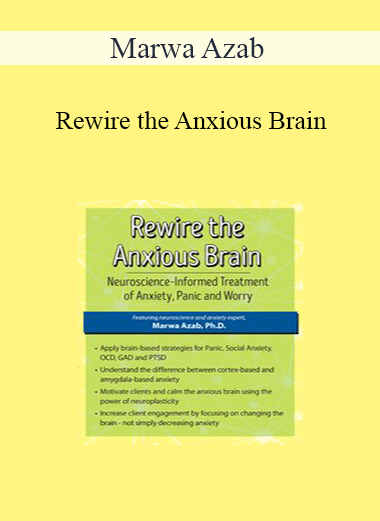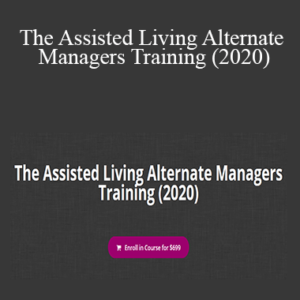- Faculty:
- Marwa Azab
- Duration:
- 5 Hours 54 Minutes
- Format:
- Audio and Video
- Copyright:
- Mar 08, 2019
Description
| Manual – Rewire the Anxious Brain (3.64 MB) | 118 Pages | Available after Purchase | |
| Instructions for ASHA Credit – SELF STUDY ONLY – 03/08/19 (38.5 KB) | Available after Purchase |
Outline
Use Neuroscience in the Treatment of Anxiety
- Positives: We know more about anxiety-based disorders than any other disorders
- Science gives explanations, evidence, authority, destigmatizes difficulties
- Concerns: It can be difficult to explain, answer questions
- Clients may feel a lack of responsibility
- Oversimplification is inevitable
Enhancing Engagement in Treatment
- Don’t neglect the therapeutic relationship!
- Address the challenges of anxious clients
- Remember that strategies are effortful
- Guide the process using client’s goals
- Maintain motivation
Neuroplasticity
- Define Neuroplasticity in everyday language
- Therapy is about creating a new self
- ”Rewiring” as an accessible concept for change
- Re-consolidation: the modification of emotional memories
Identify Two Neural Pathways to Anxiety
- Amygdala – bottom-up triggering of emotion, physicality of anxiety
- Cortex – top-down emotion generation based in cognition
- Explain the two pathways to clients
- How anxiety is initiated in each pathway and how pathways influence each other
Client Friendly Explanations
- Use illustrations to create concrete understanding
- Fight/flight/freeze responses
- The “language of the amygdala”
- Anxiety and the cortex
- Help clients recognize the two pathways to anxiety
Neuroplasticity in the Amygdala (Essential for all Anxiety Disorders, PTSD, OCD, Depression)
- Sleep and the amygdala
- The influence of exercise
- Breathing techniques to reduce activation
- Relaxation, meditation, and yoga to modify responses
- Exposure as opportunities for the amygdala to learn
- Combatting avoidance
- When anxiety indicates that the amygdala can learn new responses
- Push through anxiety to change the amygdala
Neuroplasticity in the Cortex (Essential for GAD, SAD, OCD, PTSD, Depression)
- ”Survival of the busiest” principle – strengthen or weaken specific circuitry
- The healthy (adaptive) use of worry in the cortex
- ”You can’t erase: You must replace.”
- Recognize and modify the impact of uncertainty
- Training correct uses of distraction
- Left hemisphere techniques – cognitive defusion, coping thoughts, fighting anticipation
- Right hemisphere techniques – imagery, music
- Mindfulness and anxiety resistances
Neuroplasticity and Medications for Anxiety Disorders, OCD, PTSD, Depression
- Medication’s effects in the rewiring process
- The myth of the chemical imbalance
- The danger of sedating the brain with benzodiazepines
- Promoting neuroplasticity with SSRIs, SNRIs
- The effectiveness of CBT and meds
Move Beyond Diagnostic Categories to Focus on Anxiety Pathways
- Anxiety is a component of many diagnoses (depression, substance abuse, etc.)
- Amygdala- and cortex-based techniques help in other disorders
- Targeting brain-based symptoms rather than disorders
- Worry, obsessions, rumination respond to similar cortex-based techniques
- Panic, phobic responses, and compulsions respond to amygdala-based techniques
Research, Risks and Limitations
- Empirical versus clinical and anecdotal evidence
- Clinical considerations for specific clients and settings
- Efficacy of particular interventions may vary
Faculty
Marwa Azab, Ph.D. Related seminars and products: 1
Marwa Azab, Ph.D., teaches for the Psychology and Human Development departments at Cal State University, Long Beach, (CSULB). She currently teaches the psychopharmacology course for graduate students. She has also taught for the Biology department at University of California, Irvine (UCI). Marwa studied psychology for many years and completed a masters in Counseling. She has facilitated many groups such as anger management, stress management, interpersonal communication and many others for patients suffering from a variety of mental disorders. After many years of addressing human behaviors from a psychological perspective, she realized that there were blind spots that needed to be satiated from complementary fields. Thus, she completed a Ph.D. in Biological Sciences with emphasis on Neuroscience. Marwa started life coaching utilizing an interdisciplinary approach that intersects psychology, biology and genetics.
Marwa is a sought after international public speaker who is invited to speak on a variety of interdisciplinary topics, including three TEDx talks. She recently published her first book titled, “Anxiety Disorders: New Science on Mind-Body Connections and Healing” and blogs for Psychology Today, her blog is called “Neuroscience in Everyday Life”. You can connect with her on her Facebook page: www.facebook.com/DrMarwaAzab.
Speaker Disclosures:
Financial: Marwa Azab has an employment relationship with Cal State University, Long Beach. She receives a speaking honorarium from PESI, Inc.
Non-financial: Marwa Azab writes a blog for Psychology Today called “Neuroscience in Everyday Life.”
Delivery Method
– After your purchase, you’ll see a View your orders link which goes to the Downloads page. Here, you can download all the files associated with your order.
– Downloads are available once your payment is confirmed, we’ll also send you a download notification email separate from any transaction notification emails you receivefrom coursesblock.com
– Since it is a digital copy, our suggestion is to download and save it to your hard drive. In case the link is broken for any reason, please contact us and we will resend the new download link.
– If you cannot find the download link, please don’t worry about that. We will update and notify you as soon as possible at 8:00 AM – 8:00 PM (UTC 8).
Thank You For Shopping With Us!







